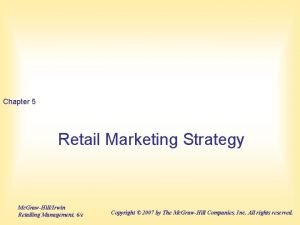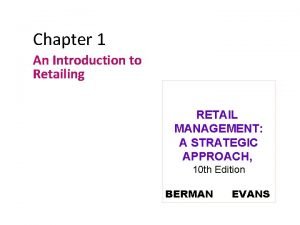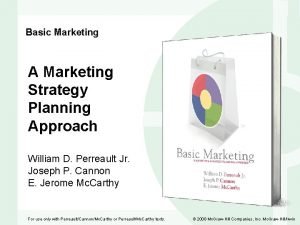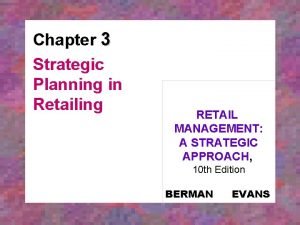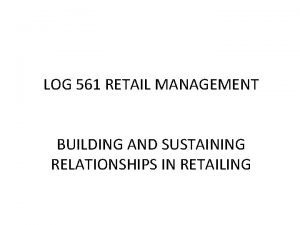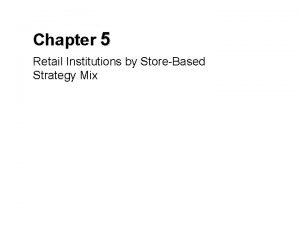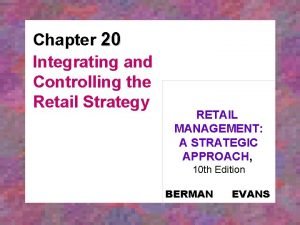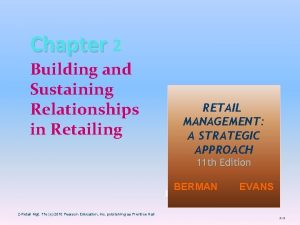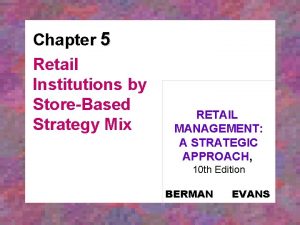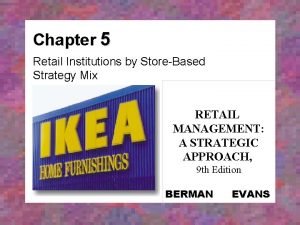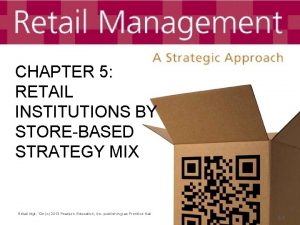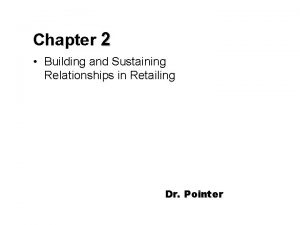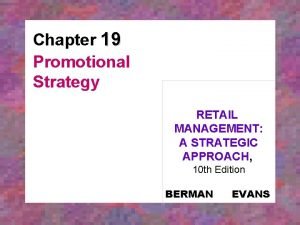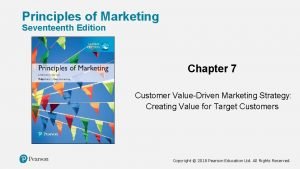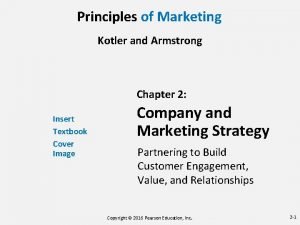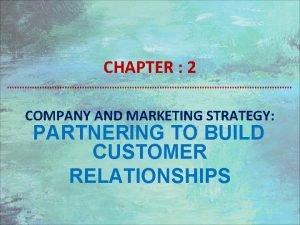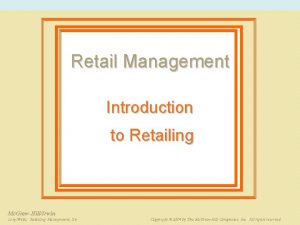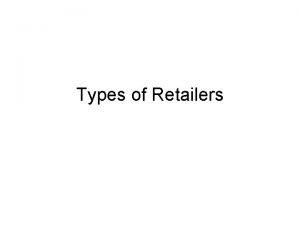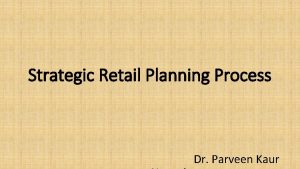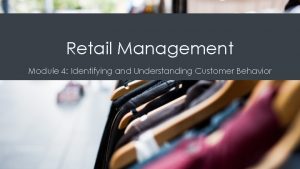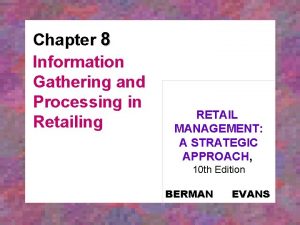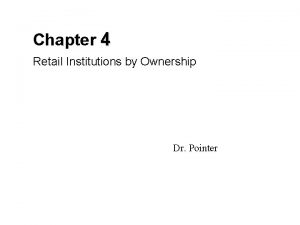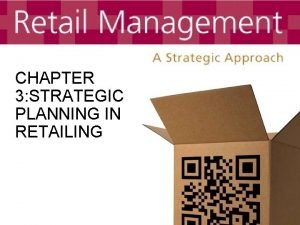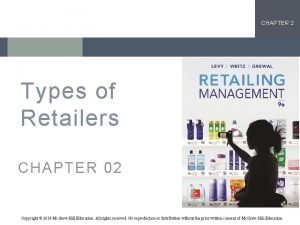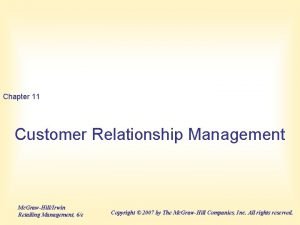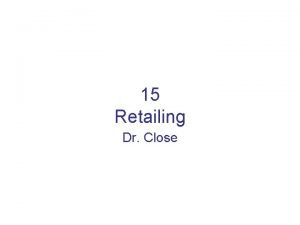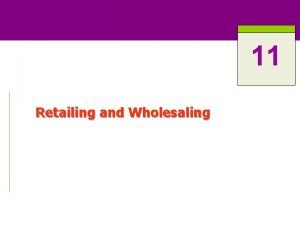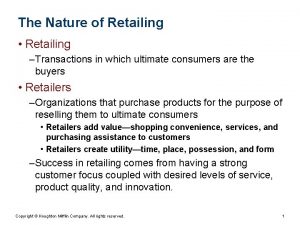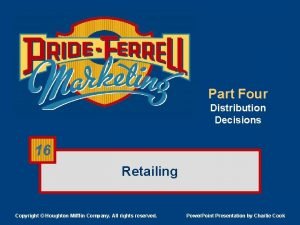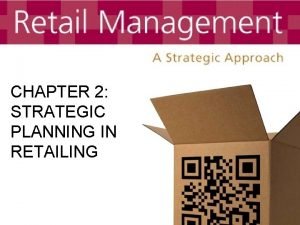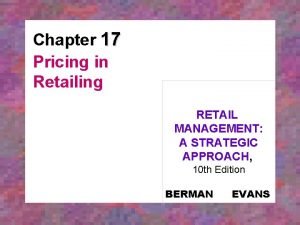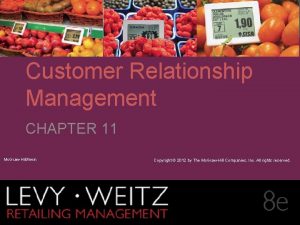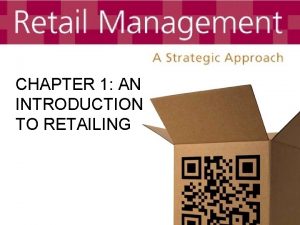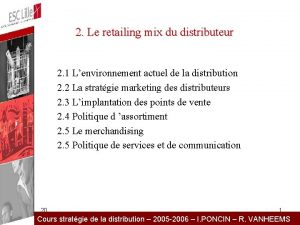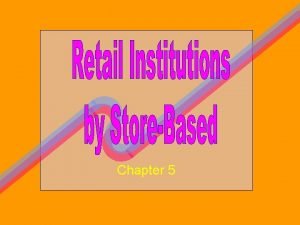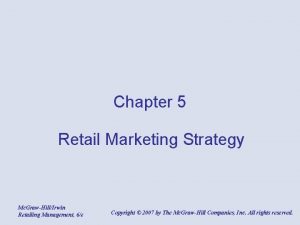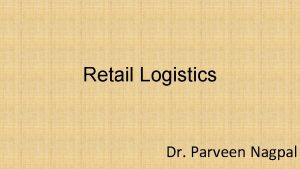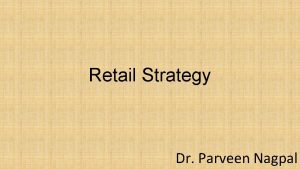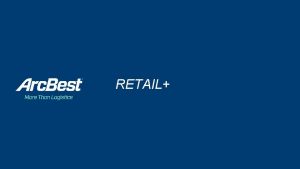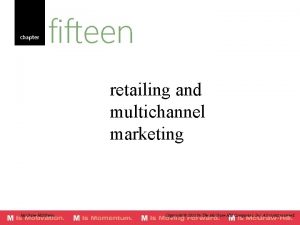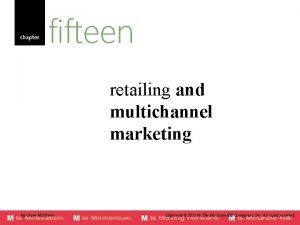Chapter 5 Retail Marketing Strategy Mc GrawHillIrwin Retailing

























































- Slides: 57

Chapter 5 Retail Marketing Strategy Mc. Graw-Hill/Irwin Retailing Management, 6/e Copyright © 2007 by The Mc. Graw-Hill Companies, Inc. All rights reserved.

2 Retailing Strategy Human Resource Management Chapter 9 Retail Locations Chapters 7, 8 Retail Market Strategy Chapter 5 Financial Strategy Chapter 6 Information and Distribution Systems Chapter 10 Customer Relationship Management Chapter 11

3 “Strategy” Is Over Used Retailers Talk About A Lot of Different “Strategies” – Sales Strategy – Advertising Strategy – Merchandise Strategy – Location Strategy Is Not Just Another Term for A Management Decision

4 Strategic vs. Tactical Decisions Strategic Tactical Direction Implementation Strategy statement Annual plan Broad Specific, detailed Unstructured Structured Problem solving Creativity Analytical External focus Internal focus Irregular Regular Long-term Short-term Difficult to evaluate Easy to evaluate Note: Success Comes for Having a Good Strategy and Executing It Well

5 Elements in Retail Strategy • Target Market Customer Needs • Retail Format Method for Satisfying Needs © image 100 Ltd • Bases for Building Sustainable Competitive Advantage Defending Position Against Competitors

6 What Is Mc. Donalds’: Target market? Retail offering (format)? Bases for competitive advantage? The Mc. Graw-Hill Companies, Inc. /John Flournoy, photographer Analyzing Mc. Donalds’ Retail Strategy What Threats Might Mc. Donald’s Face in the Future?

Examples of Retail Strategies • Starbucks • Kohls • Restoration Hardware • Ukrop’s What is the target market, retail offering, and source of competitive advantage for each retailer? 7

8 Chico’s Strategy Target Market Woman 35 to 55 Who Want Comfortable, Casual, But Stylish Apparel Retail Format Specialty Apparel Stores in Malls and Strip Centers Selling Private Label, Coordinated Outfits Bases for Building Sustainable Competitive Advantage Unique Merchandise Sized 0, 1, 2, 3

9 Strategy for Looking for a Job Determine Your Target Market – Area of Country – Type of Company – Type of Position Assess and Exploit Your Competitive Advantage – Unique Skills, Experience, Knowledge Photodisc/Punchstock

10 Why Does a Retailer Need to Focus on a Specific Target Market? Why Not Sell to Everyone?

Retail Market Opportunities for Women’s Apparel 11

Criteria For Selecting A Target Market • Attractiveness Large, Growing, Little Competition More Profits Consistent with Your Competitive Advantages 12 Rim Light/Photo. Link/Getty Images

Can A Retailer Develop a Sustainable Competitive Advantage by: 13 • Building a Store at the Best Location? • Deciding to Sell Some Hot Merchandise? • Increasing Your Level of Advertising? • Attracting Better Sales Associates by Paying Higher Wages? • Providing Better Customer Service? • Dropping the Price of Your Merchandise? Photo. Link/Getty Images

How to Develop a Sustainable Competitive Advantage 14

Internal and External Bases for Competitive Advantage Vendors, Suppliers Retail Firm • Low Cost • Large Size • Efficient Distribution, Operations • Unique Knowledge • Loyal Employees Sources of Capital 15 Customers

16 Sources of Competitive Advantage More Sustainable Less Sustainable • • • • Location Customer Loyalty Customer Service Exclusive Merchandise Low Cost Supply Chain Management • Information Systems • Buying Power with Vendors • Committed Employees Better Computers More Employees More Merchandise Greater Assortments Lower Prices More Advertising More Promotions Cleaner Stores

17 Loyalty What does loyalty mean? Is It the same as liking a store? …Going to the store frequently? Digital Vision / Getty Images

18 How Retailers Build Loyalty • Develop a strong brand for the store brands • Develop clear precise positioning strategies • Create an emotional attachment with customers through loyalty programs Royalty-Free/CORBIS

Approaches for Building Customer Loyalty 19 Unique Positioning Customer Service Information About Customers (Database) Unique Merchandise Location

20 Example of Positioning

21 Creating Store Loyalty Mental and Emotional Attachments • Elements in a Strong Brand – Top of the Mind Awareness – Associations with Brand/Store Name • Methods Used to Develop a Strong Brand – Massive Exposure – Symbols to Reinforce Image – Consistent Positioning Creating Strong Associations – Limited Brand Extensions

22 Distribution and Info Systems Flow of Information Vendor Distribution Center By decreasing costs here, the is more money available to invest in: Better services Increase in breadth and depth Decrease in prices Store Stock. Trek/Getty Images

Rob Melnychuk/Getty Images 23 Private Labels Sears’ Kenmore appliances Federated’s Inc. – fine apparel Kmart’s Martha Stewart home Jules Frazier/Getty Images JCPenney’s Arizona jeans Jacobs Stock Photography/Getty Images

24 Vendor Relationships • Low Cost Efficiency Through Coordination – Electronic Data Interchange (EDI) – Collaborative Planning and Forecasting to Reduce Inventory and Distribution Costs • Exclusive Sale of Desirable Brands • Special Treatment – Early Delivery of New Styles – Shipment of Scare Merchandise

25 High Quality Customer Service • Difficult to Achieve – People Are Not Machines -- Inconsistent – Retail Sales Associates At Bottom of Labor Pool • Goes Beyond Hiring Good People at High Wages and Training Them Organizational Culture

Critical Tradeoff In Developing Strategic Advantage Focus Leads to Developing A Competitive Advantage But Focus Reduces Flexibility • Low Cost, Consistent Image, Vendor Relationships Reduces Flexibility • Similar to Dating and Marriage – Commitment to a Relationship (Vendor) Reduces Flexibility 26

Growth Opportunities 27 • Market Penetration • Market Expansion • Retail Format Development • Diversification Ryan Mc. Vay/Getty Images Related vs. Unrelated

28 Growth Opportunities

29 Market Penetration • Attract customers from target market – Walgreens “on every corner” • Get current customer to visit store more often or buy on each visit Cross Selling – sales associates in one department sell complimentary merchandise from other departments Example: Manicurist sells services plus hand lotion or nail polish Example: Salesperson sells leaf blower directs customer to electrical department to purchase a 100 foot extension cord.

30 International Growth Opportunities Europe China Mexico Latin America Japan Steve Cole/Getty Images

Why Do Category Killers and Supercenters Succeed Globally? Developed operating expenses Scale economies for buying merchandise globally Unique systems and standardization formats that facilitate control over multiple stores Understand that consumers are willing to forego service for lower prices 31 Ryan Mc. Vay/Getty Images

Key to Success in Global Retailing • Domestic market leadership – strong base • Exploiting core competencies – competitive advantage – Low cost - Wal-Mart, Carrefour – Fashion Reputation - The Gap, Zara, H&M – Category dominance – Best Buy, Office Depot – Unique Image, Brand – Disney, IKEA, Starbucks • Adaptability • Global Culture • Long-term commitment 32

33 Succeeding Internationally Adaptability Global culture Financial resources Global sustainable competitive advantage Photo. Link/Getty Images

International Market Entry Strategies Direct Investment Joint Ventures Strategic Alliances Franchising 34

Steps in the Strategic Retail Planning Process 1. Define the business mission 2. Conduct a situation audit: Market attractiveness analysis Competitor analysis Self-analysis 3. Identify strategic opportunities 4. Evaluate strategic alternatives 5. Establish specific objectives and allocate resources 6. Develop a retail mix to implement strategy 7. Evaluate performance and make adjustments 35

36 Elements in a Market Analysis MARKET FACTORS Size Growth Seasonality Business cycles COMPETITIVE FACTORS ENVIRONMENTAL FACTORS ANALYSIS OF STRENGTHS & WEAKNESSES Barriers to entry Bargaining power of vendors Competitive rivalry Threat of superior new formats Technology Economic Regulatory Social Management capabilities Financial resources Locations Operations Merchandise Store Management Customer loyalty

37 Market Factors • Market size – large markets attractive to large retail firms • Growing markets – typically more attractive than mature or declining • Business cycles – retail markets can be affected by economic conditions – military base towns • Seasonality – can be an issue as resources are necessary during peak season only

Questions for Analyzing the Environment • New developments or changes technologies, regulations, social factors, economic conditions • Likelihood changes will occur • Key factors determining change • Impact of change on retail market firm, competitors 38

39 Competitive Factors Barriers to Entry Bargaining Power of Vendors Competitive Rivalry Threat of Substitution Large Customers

40 Competitive Rivalry • Large number of competitors all about the same size • Slow growth • High fixed costs • Lack of perceived differences between competing retailers Royalty-Free/CORBIS

41 Performing a Self Analysis • At what is our company good? • In which of these areas is our company better than our competitors? • In which of theses areas does out company’s unique capabilities provide a sustainable advantage or a basis for developing one? Stockbyte/Punchstock Images

Strengths and Weaknesses Analysis Management Capability: Capabilities and experience of top management Depth of Management--capabilities of middle management Management’s commitment to firm Financial Resources: Cash flow from existing business Ability to raise debt or equity financing Operations: Store Management Capabilities Overhead cost structure Quality of operating systems Distribution capabilities Management information systems Loss prevention systems Inventory control system Management capabilities Quality of sales associates Commitment of sales associates to firm Locations Merchandising Capabilities: Knowledge and skills of buyers Relationships with vendors Capabilities in developing private capabilities Customers Loyalty of customers 42

Illustration of the Strategic Retail Planning Process Kelly Bradford – Owner of Gifts To Go – Two Store Chain in Chicago – Target Market – Upper Income Men and Women Looking for Gifts between $50 and $500 – Strong Customer Loyalty Based on Knowing What Customers Want, Providing Good Customer Service – Low Turnover Among Associates 43

Mission Statement for Gifts To Go 44 “The mission of Gifts to Go is to be the leading retailers of higher priced gifts in the Chicago and provide a stable income of $100, 000 per year for the owner. ” Define growth opportunities will and won’t consider Indicates objective of company

Situation Analysis of Gifts to Go • Market Factors – Chicago is an attractive market. (+) – Relatively expensive gifts are not affected much by the economy. (+) – Gifts are highly seasonal. (-) • Competitive Factors – Many in area. Primary department stores, craft galleries, catalogs, and Internet retailers (-) – Lack of large suppliers, customer (+) – Opportunities for differentiation (+) – Limited competitive rivalry. (+) 45

Situation Analysis of Gifts to Go (continued) 46 • Environmental Factors – Potential Threat - Development of electronic channel by traditional bricks and mortar retailers ( -) • Strengths and Weaknesses – – – – Management Capability – Limited Financial Resources – Good Operations – Poor Merchandise Capabilities – Good Store Management Capabilities – Excellent Locations – Excellent Customer Loyalty – Good Customer Database - Good

Growth Opportunities for Gifts to Go 47 • Market Penetration – Increase size of present stores – Open additional gifts stores in Chicago area • Market Expansion – Open gift stores outside Chicago area – Sell lower priced gifts in present stores Ryan Mc. Vay/Getty Images

Growth Opportunities for Gifts to Go (continued) 48 • Retail Format Development – Sell non-gift merchandise to same customers in present or new stores – Sell similar gifts to same customers through an electronic channel • Diversification – Manufacture craft gifts – Open an apparel store targeting teenagers – Open a category killer store selling a broader assortment of gifts

49 Evaluating Growth Opportunities for Gifts to Go Market Attractiveness • Market Penetration – Increase size of present stores (low) – Open additional gifts stores in Chicago area (medium) • Market Expansion – Open gift stores outside Chicago area – new geographic segment (medium) – Sell lower priced gifts in present stores – new benefit segment (medium)

50 Evaluating Growth Opportunities for Gifts to Go (continued) Market Attractiveness • Retail Format Development – Sell non-gift merchandise to same customers in present or new stores (High) – Sell similar gifts to same customers through an electronic channel (High) • Diversification – Manufacture craft gifts (High) – Open an apparel store targeting teenagers (High) – Open a category killer store selling a broader assortment of gifts (High)

51 Evaluating Growth Opportunities for Gifts to Go Competitive Position • Market Penetration – Increase size of present stores (High) – Open additional gifts stores in Chicago area (Medium) • Market Expansion – Open gift stores outside Chicago area (Low) – Sell lower priced gifts in present stores (low)

52 Evaluating Growth Opportunities for Gifts to Go (continued) Competitive Position • Retail Format Development – Sell non-gift merchandise to same customers in present or new stores (Low) – Sell similar gifts to same customers through an electronic channel (Medium) • Diversification – Manufacture craft gifts (Low) – Open an apparel store targeting teenagers (Low) – Open a category killer store selling a broader assortment of gifts (Low)

Market Attractiveness/Competitive Position Matrix 53

Steps in Using Market Attractiveness Competitive Position Matrix • Define strategic opportunities • Identify market attractiveness and competitive position factors • Assign weight based on importance of factors • Rate opportunities on market attractiveness and competitive position • Calculate scores and evaluate opportunities 54

Characteristics of International Markets 5 9 55

Attractiveness Ratings for International Growth Opportunities 56

Competitive Position in International Growth Opportunities 57
 Retail marketing strategy ppt
Retail marketing strategy ppt Retail marketing strategy definition
Retail marketing strategy definition Retail financial management
Retail financial management Keegan global marketing
Keegan global marketing Financial strategy in retailing
Financial strategy in retailing Communication mix in retail
Communication mix in retail Organized retailing
Organized retailing Marketing research in retailing involves ________.
Marketing research in retailing involves ________. Introduction to retail business
Introduction to retail business Universal functions of marketing
Universal functions of marketing Strategic planning in retailing chapter 3
Strategic planning in retailing chapter 3 Chapter 13 retailing and wholesaling
Chapter 13 retailing and wholesaling Retail operations strategy
Retail operations strategy Value-oriented retail strategy
Value-oriented retail strategy What is retail strategy mix
What is retail strategy mix Integrated retail strategy
Integrated retail strategy Value oriented retail strategy
Value oriented retail strategy Mall management ppt
Mall management ppt Retail strategy mix
Retail strategy mix Retail strategy mix
Retail strategy mix Mix department store
Mix department store Expected and augmented value chain elements
Expected and augmented value chain elements Planning a retail promotional strategy
Planning a retail promotional strategy Retail financial strategy
Retail financial strategy Principles of marketing chapter 7
Principles of marketing chapter 7 Principles of marketing pearson slides
Principles of marketing pearson slides Company and marketing strategy chapter 2
Company and marketing strategy chapter 2 Chapter 2 company and marketing strategy
Chapter 2 company and marketing strategy Retail marketing decisions
Retail marketing decisions Retail communication mix ppt
Retail communication mix ppt Retail management levy weitz ppt
Retail management levy weitz ppt Retail marketing courses
Retail marketing courses Introduction of retail
Introduction of retail Non store retailing definition
Non store retailing definition Retail management planning process
Retail management planning process Meaning of retailing
Meaning of retailing 6 p's of retailing
6 p's of retailing Definition of multi channel retailing
Definition of multi channel retailing Features of retailing
Features of retailing Objectives of retail management
Objectives of retail management Information gathering and processing in retailing
Information gathering and processing in retailing Wholesaler-retailer franchise
Wholesaler-retailer franchise Strategic planning process for global retailing
Strategic planning process for global retailing Variety assortment
Variety assortment Service retailers
Service retailers Type of retailer
Type of retailer Retailing c
Retailing c Customer relationship management in retailing
Customer relationship management in retailing Types of retailing
Types of retailing Classification of retailing
Classification of retailing Nature of retailing
Nature of retailing Example of general merchandise
Example of general merchandise Characteristics of service retailing
Characteristics of service retailing Pricing in retailing
Pricing in retailing 1-to-1 retailing
1-to-1 retailing Coordinated effort in retailing concept
Coordinated effort in retailing concept Retailing mix
Retailing mix Scrambled merchandising
Scrambled merchandising

